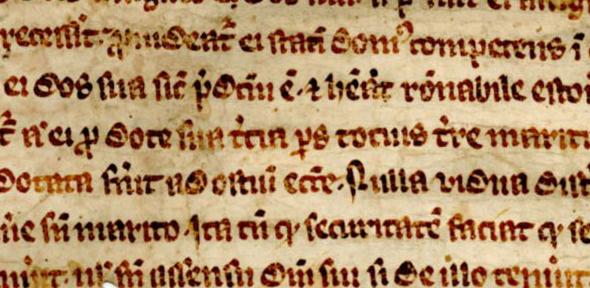Clik here to view.

A rare 14th Century copy of Magna Carta that appears to have been unnoticed for generations, until it was uncovered during research marking the document’s 800th anniversary, can be viewed online from today (Friday, 12 June).
The copy, which is owned by St John’s College, University of Cambridge, dates back to the reign of Edward I, and is one of just a handful of surviving statute rolls that recite clauses from the famous charter. Edward I was one of the monarchs who reissued a version of the Magna Carta, which was originally produced in 1215, during the reign of King John.
Although it had been preserved in the College archives, the manuscript appears to have been overlooked – and may indeed have been completely unknown to historians – until now. Its significance was only realised when Professor Nicholas Vincent, from the University of East Anglia and head of the national Magna Carta Project, contacted the College to enquire about documents that be believed contained clauses from the charter.
Professor Vincent realised that the item is, in fact, an early-to-mid 14th Century example of a type of statute roll that would have been used to circulate parts of Magna Carta throughout medieval England. While these were once commonplace, only about a dozen are known to exist today.
Ahead of the anniversary of Magna Carta, on June 15th, the College is releasing images of the copy online along with a short accompanying film. Members of the public can also view the charter by making an appointment to visit the College archives.
The document’s importance is thought to have gone undetected because no systematic attempt to collect the surviving copies of Magna Carta had been undertaken until the 800th anniversary project was launched. Even if historians had seen a record of the St John’s copy in the past, they would probably not have recognised its significance as they would have been unaware that it was in roll form.
In fact, for statute rolls of Magna Carta to survive is very rare. Earlier generations considered the parchment of which they were made very useful for secondary purposes, including lighting fires, and even as animal feed! As a result, most such rolls were lost. Judging by the valuation of similar items at auction, the St John’s copy is thought to be worth several tens of thousands of pounds.
Although it was famously agreed to by King John at Runnymeade, near Windsor, on 15 June 1215, much of Magna Carta had been repealed or rewritten within 10 years of its issue. Modified versions were reissued under both Henry III and Edward I, with some of the more radical clauses in particular removed.
Edward agreed to a renewal of Magna Carta in 1297, and then reissued it on 28 March 1300. The roll at St John’s College recites this 1300 reissue and may have been preserved by the Hospital of St John that once stood on part of what is now the College.
In common with various other copies of Magna Carta that have surfaced in the past, the manuscript is part of a larger document. In this case it was stitched together with a lawyer’s copy of the assize of bread and ale, a law which regulated the price, weight and quality of the bread and beer manufactured and sold in England, and was the first in British history to regulate the production and sale of food. The roll also recites clauses from the Forest Charter, which was issued as a companion document to Magna Carta in 1217 and dealt with rights of access to the royal forest.
The Magna Carta Project, which is led by Professor Vincent, is a collaborative initiative between several universities that aims to track down lost originals of Magna Carta and create an online database featuring commentary, translations, and research findings about the charter. The team are sifting through hundreds of archives as part of their research.
The St John’s copy is being made available to view as part of the nationwide Explore Your Archive Magna Carta campaign, in which archives around the country that have a copy of Magna Carta are being encouraged to make it available to the wider public.
Tracy Deakin, Archivist at St John’s College, said that it was not uncommon for long-forgotten historical documents to resurface from archives, many of which are being made available publically in a manner that was not possible a few decades ago. “This sort of discovery is a lot more typical than people might think,” she said. “A couple of generations back, archivists did a very different type of job and would not have been able to command the same kind of accessible detail about everything in their archive in the way that we can now.”
For more information about the St John’s College archives, including visiting times, please go to: http://www.joh.cam.ac.uk/archives
Images of a rare copy of Magna Carta at St John's College are being made available to coincide with the document's 800th anniversary.
Image may be NSFW.
Clik here to view.
The text in this work is licensed under a Creative Commons Attribution 4.0 International License. For image use please see separate credits above.